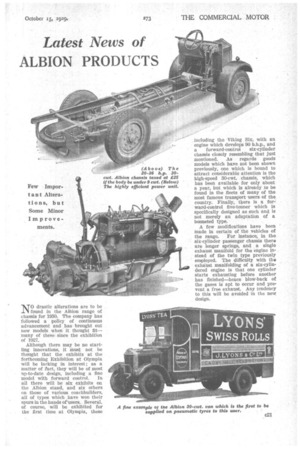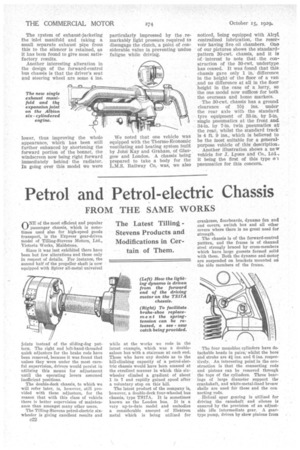Latest News of ALBION PRODUCTS
Page 59

Page 60

If you've noticed an error in this article please click here to report it so we can fix it.
NTO drastic alterations are to be
found in the Albion range of chassis for 1930. The company has followed a policy of continuous advancement and has brought out new models when it thought fit— many of these since the exhibition of 1927.
Although there may be no startling innovations, it must not be thought that the exhibits at the forthcoming Exhibition at Olympia will be lacking in interest; as a matter of /act, they will be of most up-to-date design, including a fine
model with forward control. In all there will be six exhibits on the Albion stand, and six others on those of various coachbuilders, all of types which have won their spurs in the hands of users. Several. of course, will be exhibited for the first time at Olympia, these including the Viking Six, with an engine which develops 90 b.h.p., and a forward-control six-cylinder chassis closely resembling that just mentioned. As regards goods models which have not been shown previously, one which is bound to attract considerable attention is the high-speed 30-cwt. chassis, which has been available for only about a year, but which is already to be found in the fleets of many of the most famous transport users of the country. Finally, there is a forward-control five-tonner which is specifically designed as such and is not merely an adaptation of a bonneted type.
A few modifications have been made in certain of the vehicles of the range. For instance, in the six-cylinder passenger chassis there are longer springs, and a single exhaust manifold for the engine instead of the twin type previously employed. The difficulty with the exhaust manifolding of a six-cylindered engine is that one cylinder starts exhausting before another has finished—hence blow-back of the gases is apt to occur and prevent a free exhaust. Any tendency to this will be avoided in the new design.
The system of exhaust-jacketing the inlet manifold and taking a small separate exhaust pipe from this to the silencer is retained, as it has been found to give most satisfactory results.
Another interesting alteration in the design of the forward-control bus chassis is that the driver's scat and steering wheel are some 4 ins.
lower, thus improving the whole appearance, which has been still further enhanced by shortening the forward portion of the bonnet, the windscreen now being right forward immediately behind• the radiator. In going over this model we were particularly impressed by the remarkably light pressure required to disengage the clutch, a point of considerable value in preventing undue fatigue while driving.
We noted that one vehicle was equipped with the Thermo-Economic ventilating and heating system built by John Kay and Graham, of Glasgow and London. A chassis being prepared to take a body for the L.M.S. Railway Co. was, we also
noticed, being equipped with Alcyl, centralized lubrication, the reservoir having five oil chambers. One. of our pictures shows the standardpattern 30-cwt. chassis, and it is of interest to note that the construction of the 30-cwt. undertype has ceased. It was found that this chassis gave only 1 in. difference in the height of the floor of a van and no difference at all in the floor height in the case of a lorry, so the one model now suffices for both the overseas and home markets.
The 30-cwt. chassis has a ground clearance of 101 Ins, under the rear axle with the standard tyre equipment of 33-in. by 5-in. single pneumatics at the front and 34-in. by 7-in, twin pneumatics at: the rear, whilst the standard track' Is 4 ft. 9 ins., which is believed to be the most suitable for a generalpurpose vehicle of this description,
Another illustration shows a new vehicle for J. Lyons and Co., Ltd., it being the first of this type 01 pneumatics for this concern.




























































































































